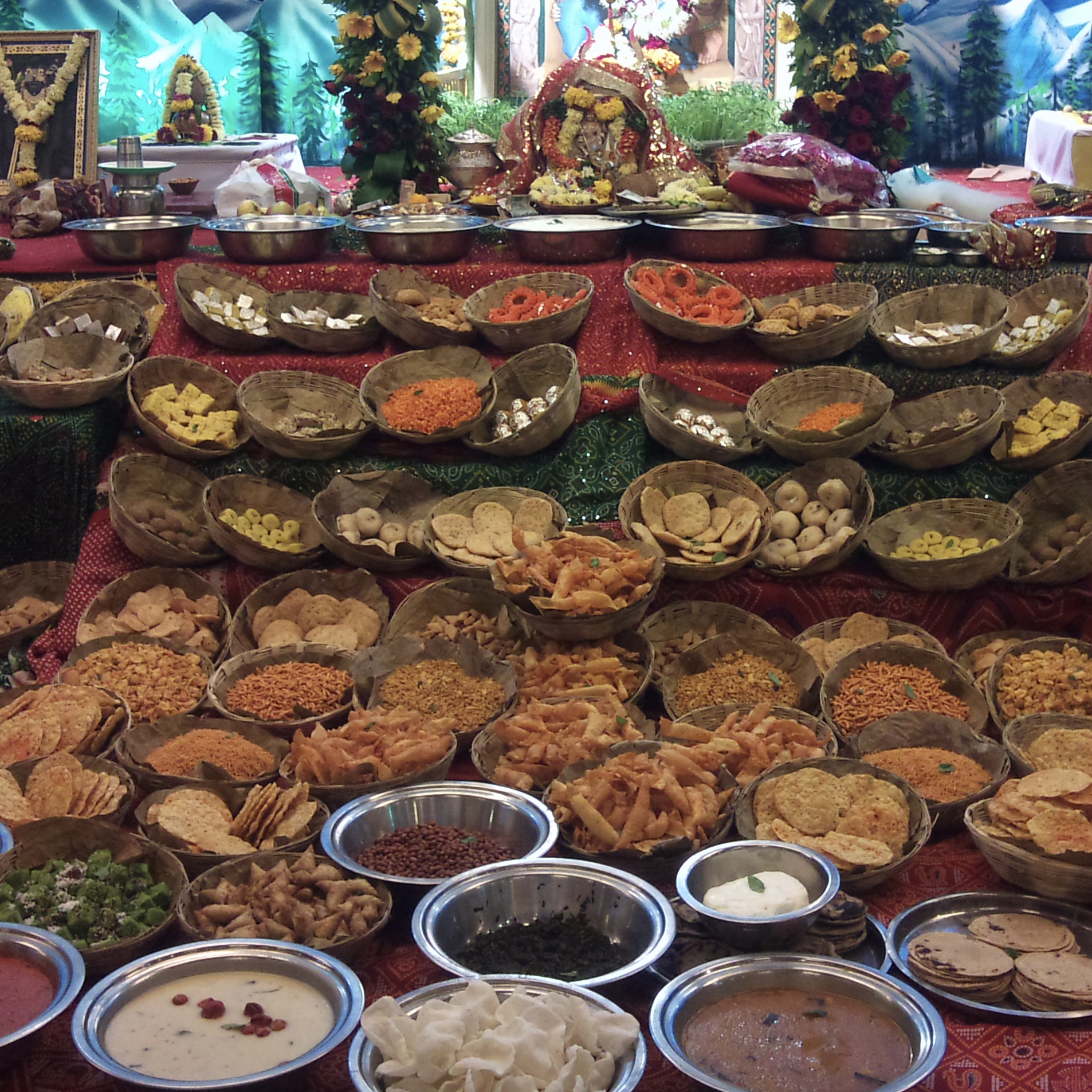In the mystical and devotional landscapes of India, food has never been viewed as mere sustenance—it is revered as prasad, a sacred offering, a medium through which the divine is worshipped and love is expressed. Among the grandest and most elaborate of such offerings is the “Chhappan Bhog” or 56 Bhog, a sumptuous and symbolic feast offered to Lord Krishna and Lord Jagannath.
The tradition of Chhappan Bhog is not just a culinary celebration; it is a deeply spiritual ritual interwoven with mythology, philosophy, culture, and heritage. Found in the temples of Puri, Vrindavan, Mathura, and other sacred sites, the 56 Bhog is emblematic of devotion at its highest form.
This article presents every intricate detail about the history, significance, spiritual essence, and origin of the 56 Bhog, especially in the context of Lord Jagannath and Lord Krishna.
What is 56 Bhog?
Chhappan Bhog literally translates to “56 offerings.” It refers to a grand arrangement of 56 varieties of food items meticulously prepared and offered to the deity as part of daily and festival rituals. These items include sweets, savories, rice dishes, lentils, vegetables, breads, chutneys, fruits, and drinks—all made in accordance with ancient culinary and religious guidelines.
The offering is made with utmost purity, devotion, and love. It is believed that once the food touches the presence of the Lord, it is no longer food—it transforms into Mahaprasad, imbued with divine energy, grace, and blessings.
Historical and Mythological Origin of 56 Bhog
The origins of the 56 Bhog can be traced back to ancient Hindu mythology, specifically to Lord Krishna’s childhood in Gokul. The most widely accepted story is linked to the legendary incident involving Govardhan Hill.
The Govardhan Leela
According to Bhagavata Purana, once the people of Gokul were preparing to perform a grand puja to Indra, the god of rain. However, young Krishna, a divine incarnation of Lord Vishnu, persuaded the villagers to worship Govardhan Hill instead, which provided them with food, shelter, and protection.
Angered by this, Indra unleashed heavy rains and thunderstorms upon Gokul. To protect the villagers and cattle, Krishna lifted the Govardhan Hill on his little finger and held it aloft like an umbrella for seven days and nights. During this time, Krishna did not eat even once.
When the storm ended and Indra surrendered, the villagers realized Krishna’s supreme divinity. Out of gratitude, the Gopis (milkmaids) and villagers prepared a feast of 8 meals a day for 7 days—8 x 7 = 56 dishes—as an offering to Krishna, marking the beginning of the Chhappan Bhog tradition.
This offering symbolizes devotion, gratitude, and the celebration of divine love between God and His devotees.
Connection of 56 Bhog with Lord Jagannath in Puri
The sacred tradition of Chhappan Bhog was later absorbed into the rituals of Lord Jagannath, who is revered as Lord Krishna Himself in the famous Jagannath Temple of Puri, Odisha.
In Puri, food offerings are a central aspect of worship, deeply integrated into daily temple procedures. Lord Jagannath’s kitchen is considered the largest and most sacred kitchen in the world, where Mahaprasad is cooked without tasting, touched only after offering to the deity, and distributed among thousands of devotees.
During special days like Govardhan Puja, Annakut, and major Rath Yatra rituals, the Chhappan Bhog is prepared and offered to Lord Jagannath, Balabhadra, and Subhadra, reflecting the Govardhan Leela’s spirit in Jagannath worship.
Detailed Composition of 56 Bhog
The 56 items offered in Chhappan Bhog vary slightly across regions and temples, but they typically include a rich variety of dishes that reflect:
- Sattvic principles (pure, non-spicy, vegetarian food)
- Seasonal ingredients
- Ancient Ayurvedic dietary rules
Here is a rough categorization of the types of dishes included:
1. Sweets (20–25 items)
- Laddoo (varieties like besan, boondi, til)
- Rasgulla
- Kheer (rice pudding)
- Peda
- Sandesh
- Malpua
- Gaja
- Khaja (special in Puri)
- Rabri
2. Rice-Based Dishes
- Ghee rice
- Lemon rice
- Khichdi
- Pulao
- Rice with curd (Dahi Bhata)
- Coconut rice
3. Vegetables & Curries
- Pumpkin curry
- Brinjal fry
- Spinach curry
- Mixed vegetable sabzi
- Raw banana curry
4. Pulses and Lentils
- Dalma (a traditional Odia dish with lentils and vegetables)
- Mung dal
- Chana dal
5. Breads
- Poori
- Kachori
- Chapati (dry)
- Puffed rice mixture
6. Chutneys and Side Dishes
- Tamarind chutney
- Mint chutney
- Raw mango chutney
7. Fruits and Beverages
- Seasonal fruits (banana, apple, guava)
- Sweet lime juice
- Buttermilk
- Coconut water
These offerings are beautifully arranged in silver or brass utensils and presented with sacred chanting and ritualistic movements in front of the deity.
Philosophical and Spiritual Significance
The offering of 56 Bhog is not simply about abundance or opulence—it is a spiritual gesture of devotion, humility, and surrender. The bhog is offered with the belief that the Lord accepts even a single grain offered with pure love.
Chhappan Bhog teaches:
- Ananya Bhakti (exclusive devotion): Krishna’s acceptance of the villagers’ love over celestial rituals shows that God values pure-hearted devotion above all.
- Annadana Mahadan (giving food is the greatest charity): The shared consumption of Mahaprasad reflects the equality and community values in Vaishnavite traditions.
- Unity in diversity: The variety of dishes represents the rich diversity of India’s culinary traditions and devotion expressed in different forms.
Modern Observance and Cultural Impact
The tradition of 56 Bhog has continued over the centuries and is celebrated in temples and homes across India and abroad. Especially during festivals like:
- Govardhan Puja
- Rath Yatra
- Janmashtami
- Annkut Mahotsav
In temples like Banke Bihari (Vrindavan), Dwarkadhish (Gujarat), and ISKCON temples worldwide, elaborate Chhappan Bhogs are offered and then distributed as prasadam to thousands of devotees.
Even in modern times, devotees prepare 56 Bhog at home during festivals as a symbolic act of surrender and love toward Lord Krishna or Jagannath.
Conclusion
The tradition of 56 Bhog, rooted in mythology, nurtured by faith, and sustained by cultural practice, stands as a magnificent expression of devotional hospitality—offering the best of human creativity and love to the divine.
Whether experienced in the sacred atmosphere of the Jagannath Temple in Puri or recreated in a devotee’s home kitchen, the 56 Bhog reminds us of a timeless truth: God does not seek richness in offerings but richness in devotion.
In the rhythmic preparation of each dish, the sacred chants echoing through temple halls, and the serene smile on the deity’s face as the offerings are placed before Him, lies the essence of Bhakti—a connection between the human and the divine, forged through flavor, fragrance, and faith.


